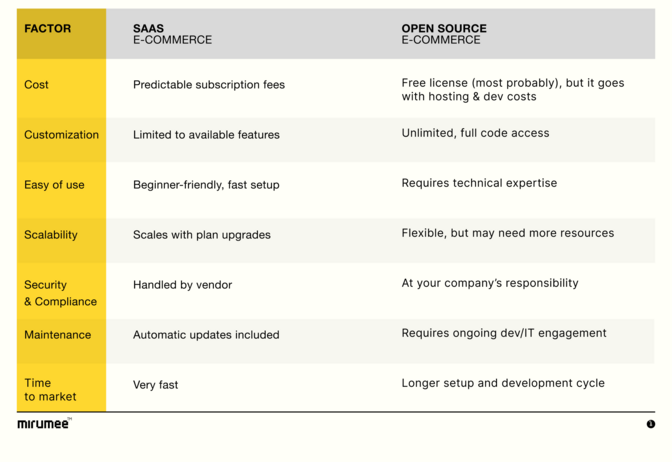Open Source vs Saas in E-Commerce: Which One Should You Choose?
When choosing between SaaS vs open source for your e-commerce business, the decision can significantly impact your operations, budget, and growth potential. How can you know which one is better for you?
SaaS e-commerce platforms operate on a subscription-based model, where businesses pay monthly or annual fees for usage. These platforms come with built-in hosting and security privileges, eliminating the need for individual setup.
On the contrary, open source software is freely available for anyone to use, modify, and distribute. It allows you to work independently and use a variety of tools or templates.
In this article, we'll examine both options to help you determine which solution best fits your business needs. We'll compare their features, analyze cost implications, and provide clarity on whether a SaaS e-commerce platform or an open source solution is right for you.
Understanding Open Source E-Commerce Platforms
Open source e-commerce platforms, such as Saleor, give businesses full access to the source code. That translates to tailored functionality, easy integration with third-party tools, and huge community support.
Key Characteristics of Open Source E-Commerce Platforms:
- Full control: unlimited customization and integration options.
- One-time license cost (often free) but requires hosting, development, and ongoing maintenance
- High flexibility: ideal for businesses with unique workflows or advanced product catalogs.
- Ownership of data: no dependency on a vendor’s infrastructure.
Best for: companies with strong in-house technical resources or those requiring tailored e-commerce solutions.
Understanding SaaS E-Commerce Platforms
SaaS (Software as a Service) e-commerce platforms, such as Shopify, BigCommerce, or Wix, are designed for businesses that want a ready-to-use solution.
Key Characteristics of SaaS E-Commerce Platforms:
- Subscription-based pricing: predictable monthly or annual fees.
- Built-in infrastructure: hosting, maintenance, and security updates are handled by the vendor.
- Ease of use: non-technical teams can quickly launch and manage stores.
- Scalability: easy to add features or upgrade plans as traffic grows.
Best for: companies that want to minimize technical overhead and prioritize speed to market.
Comparing Open Source and SaaS E-Commerce
Here’s a quick overview of how both models compare on critical factors:

Pros and Cons of Open Source and SaaS E-Commerce
Advantages of Open Source E-Commerce
- Maximum flexibility and control
- Strong community support and plugins
- No reliance on a single vendor
- Potentially lower long-term costs (if managed well)
Drawbacks of Open Source E-Commerce
- Higher upfront investment in development
- Requires dedicated IT resources
- Security and compliance are on you
Advantages of SaaS E-Commerce
- Faster entry - you can launch within days
- Vendor-managed security and hosting
- 24/7 customer support
- Scalable plans to match business growth
Drawbacks of SaaS E-Commerce
- Limited customization and control
- Potential risk of dependence on one provider
- Monthly costs add up over time
How to Decide Which Is Right for Your Business?
The decision comes down to resources, priorities, and growth plans.
If you’re an early-stage e-commerce business that values speed, simplicity, and predictable costs, a SaaS e-commerce platform may be the right choice.
If your business has complex requirements, strong development capabilities, or a need for complete control, an open source e-commerce platform will be more future-proof.
Many growing companies even adopt a hybrid approach: they start with SaaS for quick entry, then migrate to open source as customization needs to expand.
In Conclusion
Choosing between open source vs SaaS e-commerce isn’t about which model is “better” in absolute terms. It’s about which aligns with your budget, technical capacity, and long-term vision.
SaaS offers speed, simplicity, and vendor-managed convenience.
Open source offers control, flexibility, and ownership.
Evaluate where your business stands today, and where you want it to be in long term. That perspective will guide you toward the e-commerce platform that best supports your goals.
Weighing your options?
Let’s figure out together what’s best for your business.